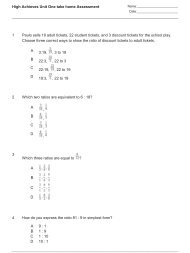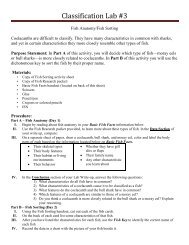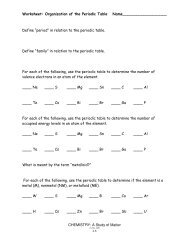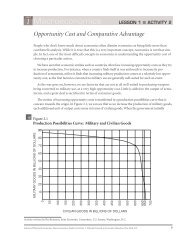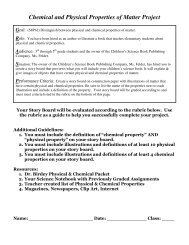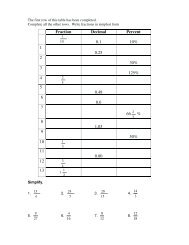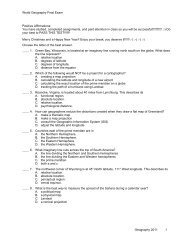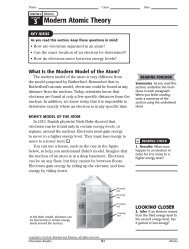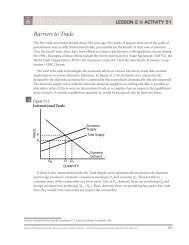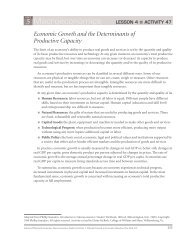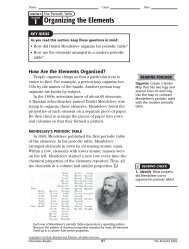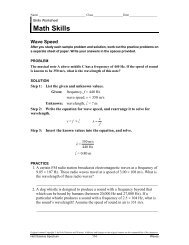Notes on Biogeochemical Cycles and Ecology.pdf
Notes on Biogeochemical Cycles and Ecology.pdf
Notes on Biogeochemical Cycles and Ecology.pdf
You also want an ePaper? Increase the reach of your titles
YUMPU automatically turns print PDFs into web optimized ePapers that Google loves.
many organisms (including humans). In others, however, DDT is deadly or may havemore insidious, l<strong>on</strong>g-term effects. In birds, for instance, DDT interferes with thedepositi<strong>on</strong> of calcium in the shells of the bird's eggs. The eggs laid are very soft <strong>and</strong>easily broken; birds so afflicted are rarely able to raise young <strong>and</strong> this causes a declinein their numbers. This was so apparent in the early 1960's that it led the scientistRachel Cars<strong>on</strong> to postulate a "silent spring" without the sound of bird calls. Her book"Silent Spring" led to the banning of DDT, the search for pesticides that would notbiomagnify, <strong>and</strong> the birth of the "modern" envir<strong>on</strong>mental movement in the 1960's.Birds such as the bald eagle have made comebacks in resp<strong>on</strong>se to the banning of DDTin the US. Ir<strong>on</strong>ically, many of the pesticides which replaced DDT are more dangerousto humans, <strong>and</strong>, without DDT, disease (primarily in the tropics) claims more humanlives.Summary:In order for a pollutant to biomagnify, the following c<strong>on</strong>diti<strong>on</strong>s must be met:1. The pollutant must be l<strong>on</strong>g-lived.2. The pollutant must be c<strong>on</strong>centrated by the producers.3. The pollutant must be fat-soluble.You can read more about biological magnificati<strong>on</strong> in the next secti<strong>on</strong>.Human vs. Natural Food ChainsHuman civilizati<strong>on</strong> is dependent <strong>on</strong> agriculture. Only with agriculture can a fewpeople feed the rest of the populati<strong>on</strong>; the part of the populati<strong>on</strong> freed from raisingfood can then go <strong>on</strong> to do all the things we associate with civilizati<strong>on</strong>. Agriculturemeans manipulating the envir<strong>on</strong>ment to favor plant species that we can eat. Inessence, humans manipulate competiti<strong>on</strong>, allowing favored species (crops) to thrive<strong>and</strong> thwarting species which might otherwise crowd them out (weeds). In essence,with agriculture we are creating a very simple ecosystem. At most, it has <strong>on</strong>ly threelevels - producers (crops), primary c<strong>on</strong>sumers (livestock, humans) <strong>and</strong> sec<strong>on</strong>daryc<strong>on</strong>sumers (humans). This means that little energy is lost between tropic levels, sincethere are fewer trophic levels present.This is good for humans, but what type of "ecosystem" have we created? Agriculturalecosystems have several problems. First, we create m<strong>on</strong>ocultures, or fields with <strong>on</strong>ly<strong>on</strong>e crop. This is simplest for planting, weeding, <strong>and</strong> harvesting, but it also packsmany similar plants into a small area, creating a situati<strong>on</strong> ideal for disease <strong>and</strong> insectpests. In natural ecosystems, plants of <strong>on</strong>e species are often scattered. Insects, whichoften specialize <strong>on</strong> feeding <strong>on</strong> a particular plant species, have a hard time finding the



